Long tail keywords should be part of the SEO strategy for any website.
This is especially true for new sites, as long tail keywords are usually less competitive terms, meaning that a new site can rank well for them.
This is a complete guide explaining what they are, their importance, and how to find them with long tail keyword research tools.
Where did long tail keywords get their name from?
Long tail keywords got their name from the book The Long Tail by Chris Anderson. In this book, he uses the case study of Amazon and how 80% of their revenue comes from just 20% of their best-selling books.
The last 20% of revenue comes from 80% of books – and these books are known as the long tail.
While this long tail of books may only sell a few copies each year – there are so many of them, the total revenue from their sales ends up being a very significant amount.
As Amazon gets known for stocking every book you could ever dream of ordering, unlike a bricks-and-mortar bookshelf that only has physical space for bestsellers, Amazon becomes the first choice for a book order, whether you want a best seller or an obscure fishing book published in 1983!
That’s the economics of how the long tail works for Amazon, but how does it help us with SEO and the long tail?
So what are long tail keywords?
You can consider high traffic keywords as the best sellers of the book world. Speak to any author and they’ll tell you how hard it is to write a bestseller!
It’s the same with high traffic keywords, they are difficult to rank for because everybody wants to rank #1 and on the first page for them in the search engines.
From now on we’ll refer to these types of high traffic keywords as ‘head terms’.
Head term examples
A head term is:
- High search volume
- Usually 1-3 words long
- Difficult to rank for
These terms are difficult to rank for, because of the number of websites (with strong backlinks) that target them. These websites target them because they are high search volume. 🙂
Some examples of head terms are:
- Running shoes
- Pet snacks
- Vegan meals
Going back to the book example, head terms make up the 20% of keywords that get 80% of the search volume.
Long tail keyword examples
Long tail keywords are searches with lower competition and search volume. They usually are longer than 3 words as users are looking for more specific information.
Some examples of long tail keywords are:
- Blue running shoes for men under $75
- Healthy snacks for kittens allergic to lactose
- 15 minute to cook vegan meals with tofu under 300 calories
Total organic search traffic can add up to a decent amount each month if you target enough long tail keywords.
Although a generalisation, we could say that long tail keywords make up 80% of the unique queries that get 20% of the volume.
Don’t be put off by this 20% number.
In terms of Google and organic search traffic, 20% of global monthly search traffic is a humongous amount of clicks!
This is especially true when you consider a large amount of the head terms or 80% are brand searches such as TikTok and Facebook, or very general searches such as holidays or shoes.
An example of a head term and a long tail keyword
Let’s consider a golf website to look at some examples.
Head terms get high search volume and are difficult because everybody tries to rank for them. These are the typical terms a keyword research tool would bring to your attention.
For golf, let’s consider the broad topic ‘pitching wedge’.
This keyword gets 2,600 searches per month in the US, and if we look at the sites ranking in the top 10 for this term, they all have high domain authority.
So, this would be a tough keyword for a new site that doesn’t have a strong backlink profile.
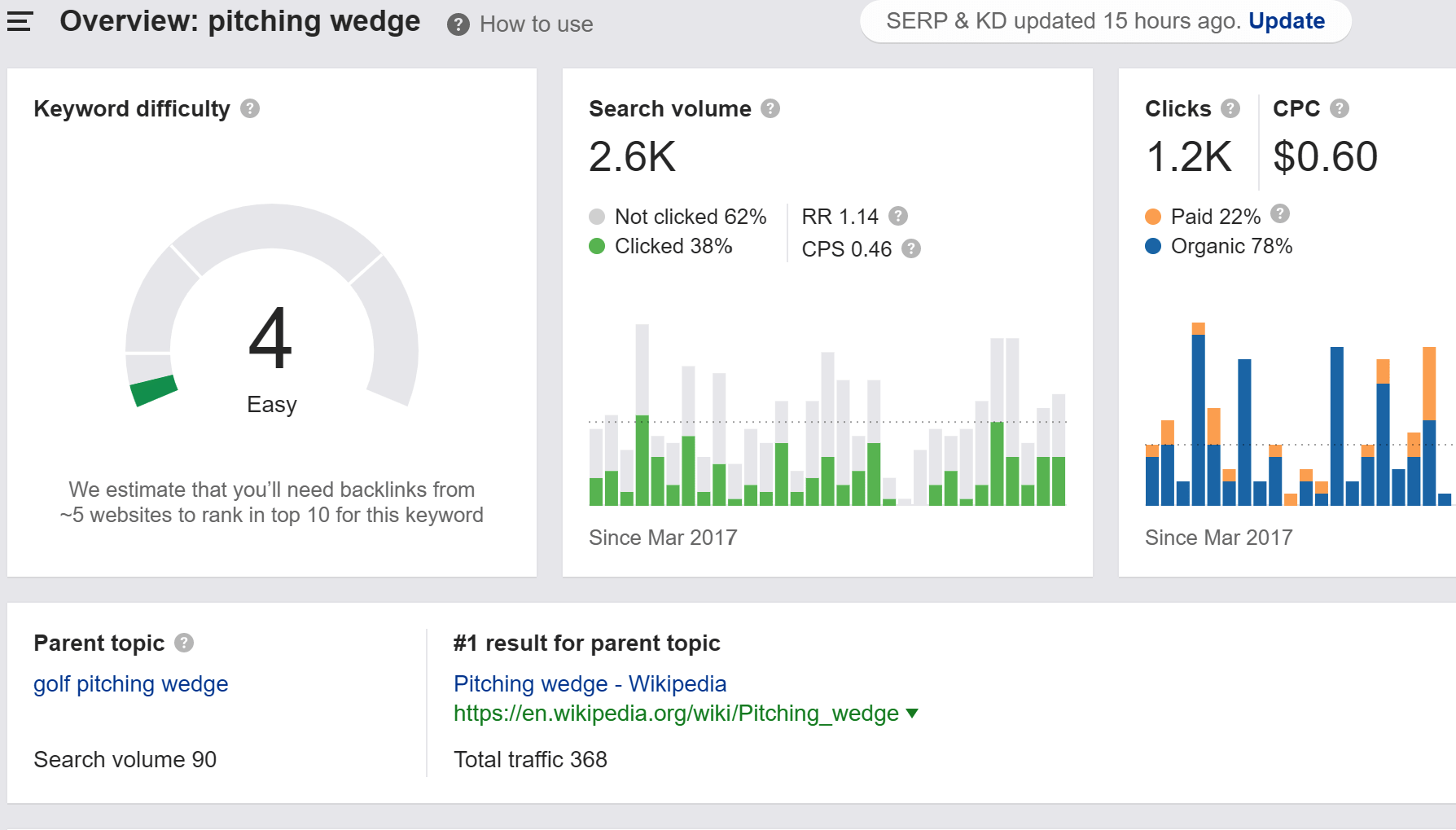
It’s also worth noting that Google finds over 32 million results for this search term – that’s a massive amount of content to try and rank against!

Looking at the various related questions for ‘pitching wedge’ in ahrefs.com, ‘what degree is a pitching wedge’ is listed as a possible long tail search.
Surprisingly this gets 1,100 monthly searches and looking at the domain authority of the sites ranking in the top 10, we have a much better chance of ranking for this term.

You can also see that Google only returns just over 3 million results from the search results. Still a large number, but 10 times less than the head search term!


Why use long tail keywords?
Targeting long tail keywords is worth it because they are easier to rank, and often have higher conversion rates if they are transaction based.
For new websites, as they don’t have a strong backlink profile, ranking for head terms is practically impossible.
Thus focusing on these long tail keywords will kickstart their journey of getting organic search traffic from Google, and eventually some links from other websites.
Easier to rank
Long tail keywords are easier to rank as less websites target them. This is because their search volume is lower.
Big websites usually don’t have dedicated pages to these long tail variations because they don’t consider it worth putting in the effort of creating a page for such a low search volume.
Be aware however, that keyword research tools that estimate search volume often massively underestimate the search volume of long tail keywords
We have regularly seen estimated search volume numbers between 0-10 monthly searches for many long tail keywords, but upon seeing first party data in Google Search Console, the keywords get hundreds and sometimes thousands of impressions per month
Higher conversion
Often these long tail keywords are made up of a larger number of words, so the users are more specific in what they are searching for.
If you address their keyword phrase in your page, title, and meta description, users are more likely to convert into a purchase upon reaching your site – assuming your product or service addresses their need.
Another consequence of a dedicated page answering a long tail query is a higher click through rate from search results.
Imagine searching on Google for ‘Healthy snacks for kittens allergic to lactose’.
Would you be more likely to click on a page titled ‘Best snacks for cats and dogs’ or ‘Healthy snacks for kittens allergic to lactose’?
For sure, option 2 is more attractive to potential customers. This is an example of a high-converting long-tail keyword.
More specific search intent
As well as looking at keyword difficulty, we need to consider the searcher’s intent when they put a query into the Google search box – or at least what Google thinks the users’ intent is.
Certain queries bring back certain types of search results. For example, searching for ‘golf balls‘ brings back ecommerce sites product listings.
However, you’d have a hard time getting a page to rank that explains the history of golf balls. Especially as Google thinks people are looking to buy golf balls for that query.
While this is not true for all queries, quite often, a lot of head terms are product/service related and therefore bring back product/service related pages.
If you are looking to create informational-type content, you will have an easier time ranking and getting traffic from long tail keywords and searches.
How to identify long tail keywords you are ranking for
The best place to start is by looking at what you already rank for.
Although your SEO content strategy up until now might not have included a long tail strategy, your site will be appearing for long tail keywords anyway based on the way Google analyses web pages and relates topics and keywords.
Google Search Console reports the keywords your site appears for in Google’s search results.
You might have targeted a specific head term, but Google will also rank your page for associated long tail keywords.
Although you appear in the SERP (SEarch Results Page) for these long tail keywords, it’s likely you will not rank exceptionally high for them if you aren’t explicitly addressing them on your page.
The task is to identify these long tail keywords, and create new articles that specifically answer the query and address the searchers intent.
We can assume that you will rank well for these long tail keywords because you have managed to rank for them without directly targeting them.
If you were to target them with a great piece of content directly, you are much more likely to achieve better rankings.
Find Long Tail Keyword using Google Search Console
Through Google Search Console, you can see the top 1,000 keywords your site has appeared for in the SERP each day.
To find long tail keywords with 5 or more words, we can use a RegEX filter.
1. Go to the performance section of Google Search Console and click “+ New”, and filter by Query.
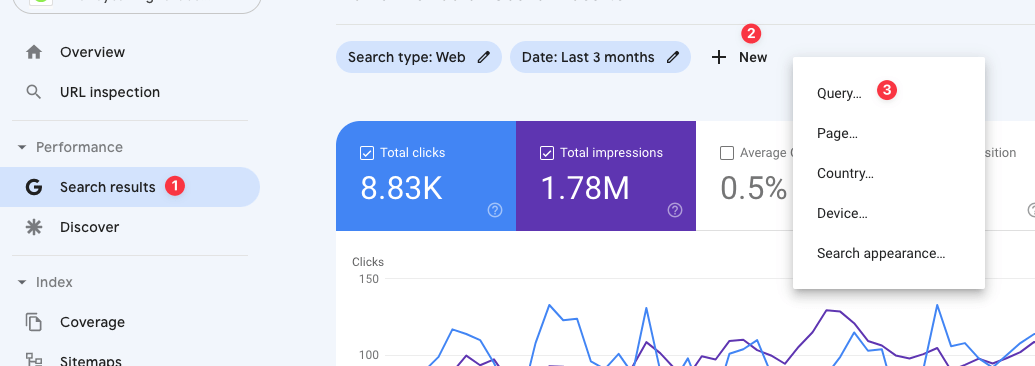
2. Use the option Custom (RegEx) and the following expression to find queries with 5 or more words.
([^” “]*\s){4,}?
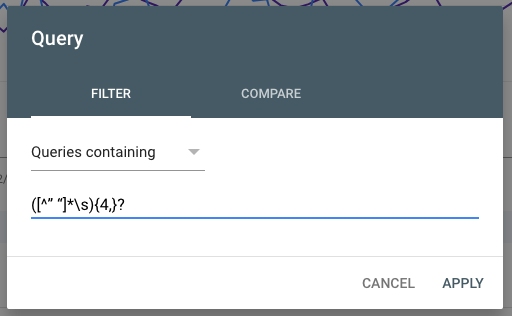
3. Now you can start looking through the keywords returned by this filter that are of 5 or more words. It is worth sorting these results by impression, so you can see which (for your site) get the most searches.
These could be good long tail candidates for adding to sections to existing pages or that deserve their own pages.
Using SEOTesting.com
SEOTesting.com uses the Google Search Console API which means we can report on all the queries your site ranks for. SEOTesting isn’t constrained in the way Google Search Console is in terms of only showing you the top 1,000 rows of data.
This means SEOTesting.com can surface thousands more long tail keyword opportunities to you, giving you many more opportunities to find an interesting list of keywords
In addition, you will find information much faster with all this keyword data, combined with our pre-built reports.
LONG TAIL KEYWORDS REPORT
SEOTesting has a Long Tail Keywords report, which is perfect for finding long tail queries.
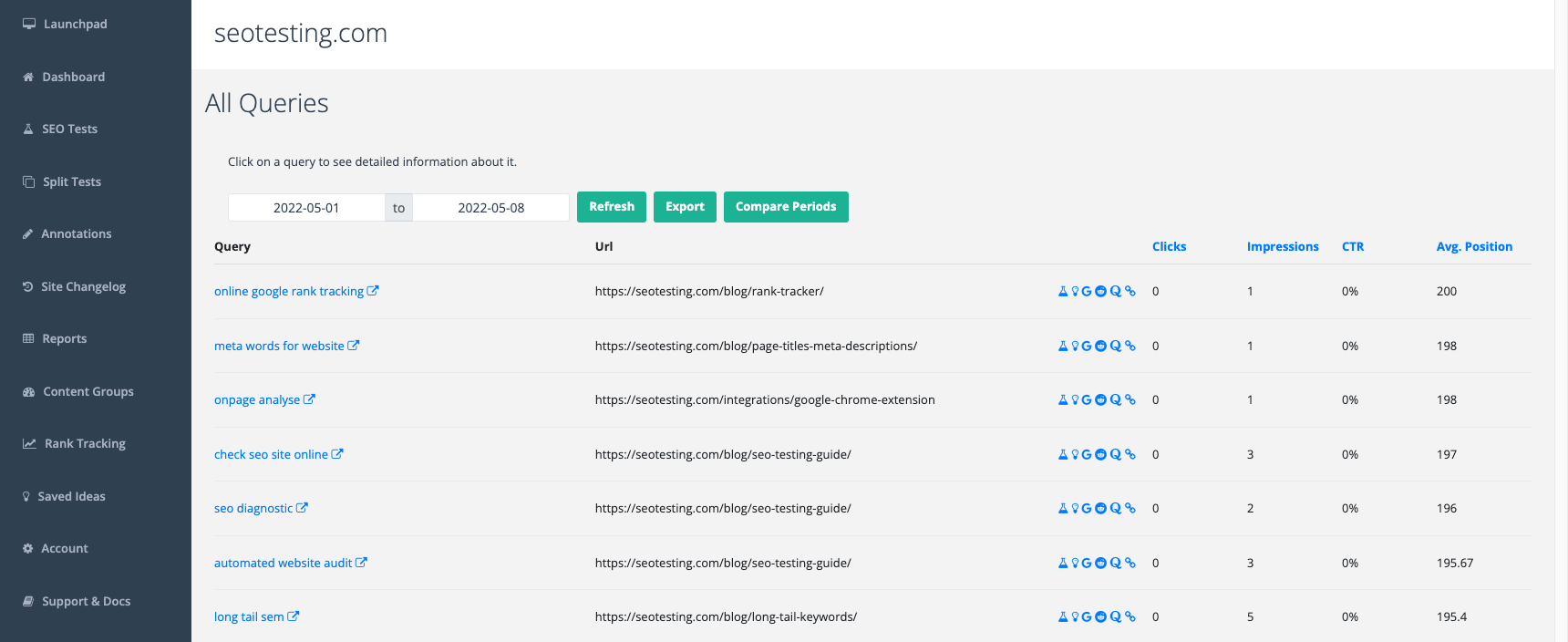
The report shows the keywords you are ranking for based on the date range selected. By default, it is ordered to show the worst ranking queries first as in theory these are at the very end of your sites long tail.
Usually, this report has hundreds of long tail keyword ideas. To help you give context to information, we show the URL ranking for the query. This should help you decide whether it is a new content opportunity, or where you should add a section to an existing page.
QUESTIONS REPORT : WHAT PEOPLE ALSO ASK
Questions make great long tail keywords, simply because they add intent to the query. In SEOTesting we search through the universe of search queries your site has ranked for and bring them all out. Each one of the results in this report could be a long tail keyword opportunity, or an opportunity to add a new FAQ to an existing article on your site.
SEARCH INTENT KEYWORDS REPORT
Question type queries are known within SEO to have informational intent, but there are other types of intent that we bucket queries into such as transactional, commercial and navigational.
SEOTesting also allows you to create a custom list of intent keywords which can be niche and sector specific.
The Search Intent report within SEOTesting allows you to filter keywords based on intent.
While the informational intent will bring back the same queries as the Questions report above, you do get the opportunity to review the other intent based lists which will highlight different keyword opportunities.
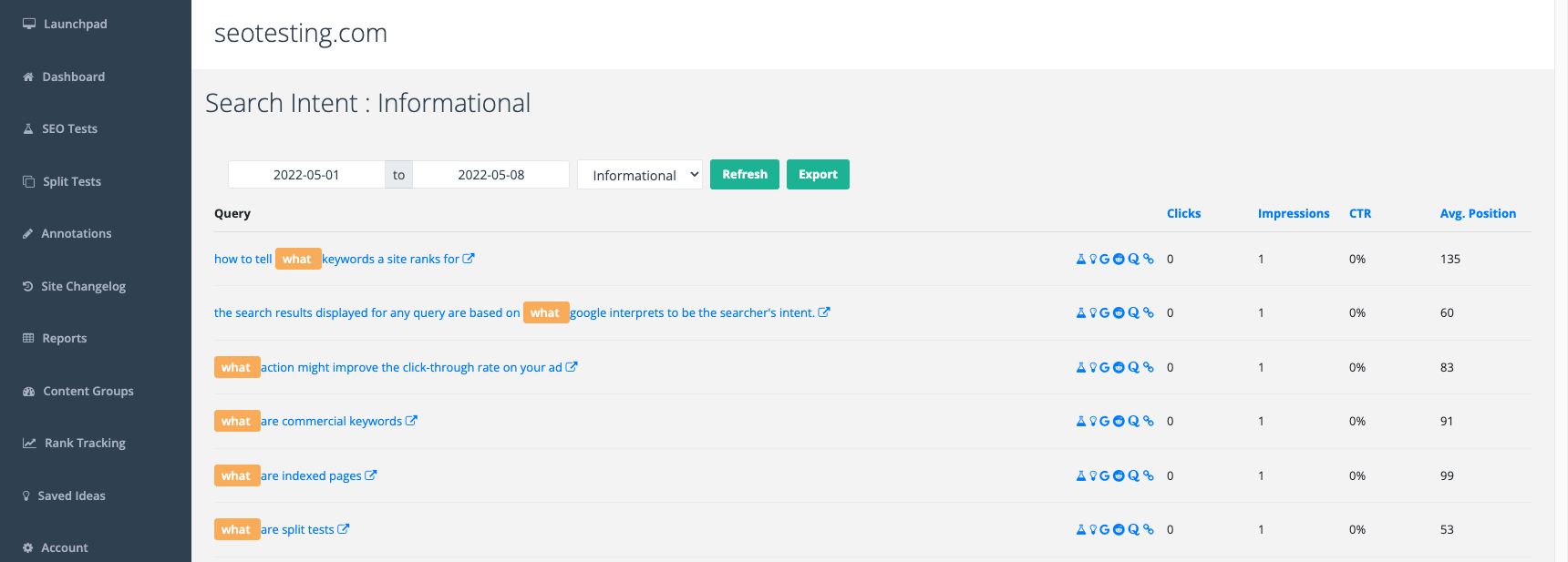
NEW KEYWORDS REPORT
Even if you haven’t added new content to your site for 3-6 months, as Google refines its understanding of topics and keywords, and new trends occur, your site will rank for new terms and queries.
This is where the New Keywords report comes in handy.
It shows a list of the keywords your site ranked for the first time over the last 5 weeks. You’ll also find accidental keywords in this weekly report.

As you publish more content, this report gets full of new keyword phrases for which your site has started to rank. Check this report once a week, and save new ideas for long tail content.
Speaking of saving ideas, we have a report for that.
SAVE YOUR LONG TAIL KEYWORD IDEAS
You can find the Saved Ideas area on the left sidebar of SEOTesting, so you can save your keyword ideas when viewing reports and come back to them later.
This is particularly useful as the reports listed above generally contain a lot of keywords to scroll through.
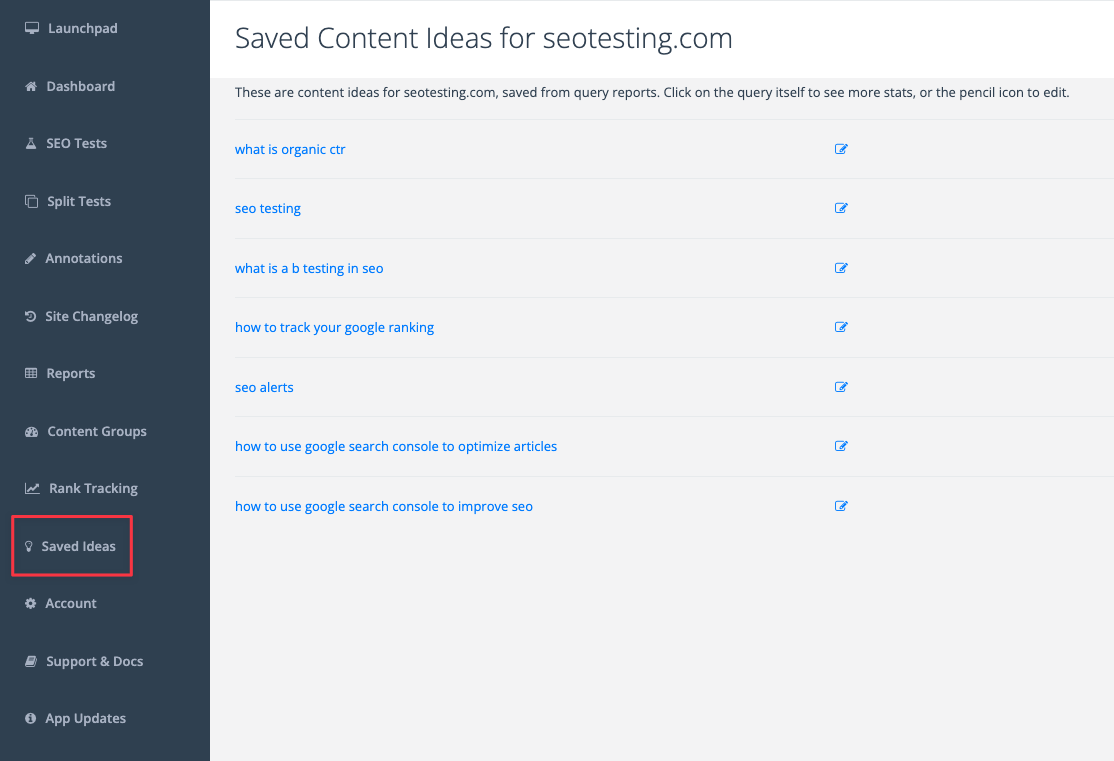

Best long tail keyword research tools
As well as using first party data tools such as Google Search Console and SEOTesting, there are other options available for long tail keyword research.
Ahrefs and SEMRush
People doing SEO usually have a subscription to either ahrefs or SEMRush.
Both of these tools are good for doing competitor research, and finding long tail keywords opportunities.
Looking at competitor websites and setting a low keyword difficulty range will show the long tail keywords your competition is ranking for.
Forums – Reddit, Quora, etc.
Forums like Reddit and Quora are gold mines for finding long tail keyword ideas. They help you find questions and problems users face regularly face.
Q-stats, Redditfavorites and Redditlist are some of the best tools to help you do research and spot emerging trends.
For example, Q-stats is a free long tail keyword research tool for Quora that shows how many views a post has, the estimated SEO traffic, and opportunity for ranking.
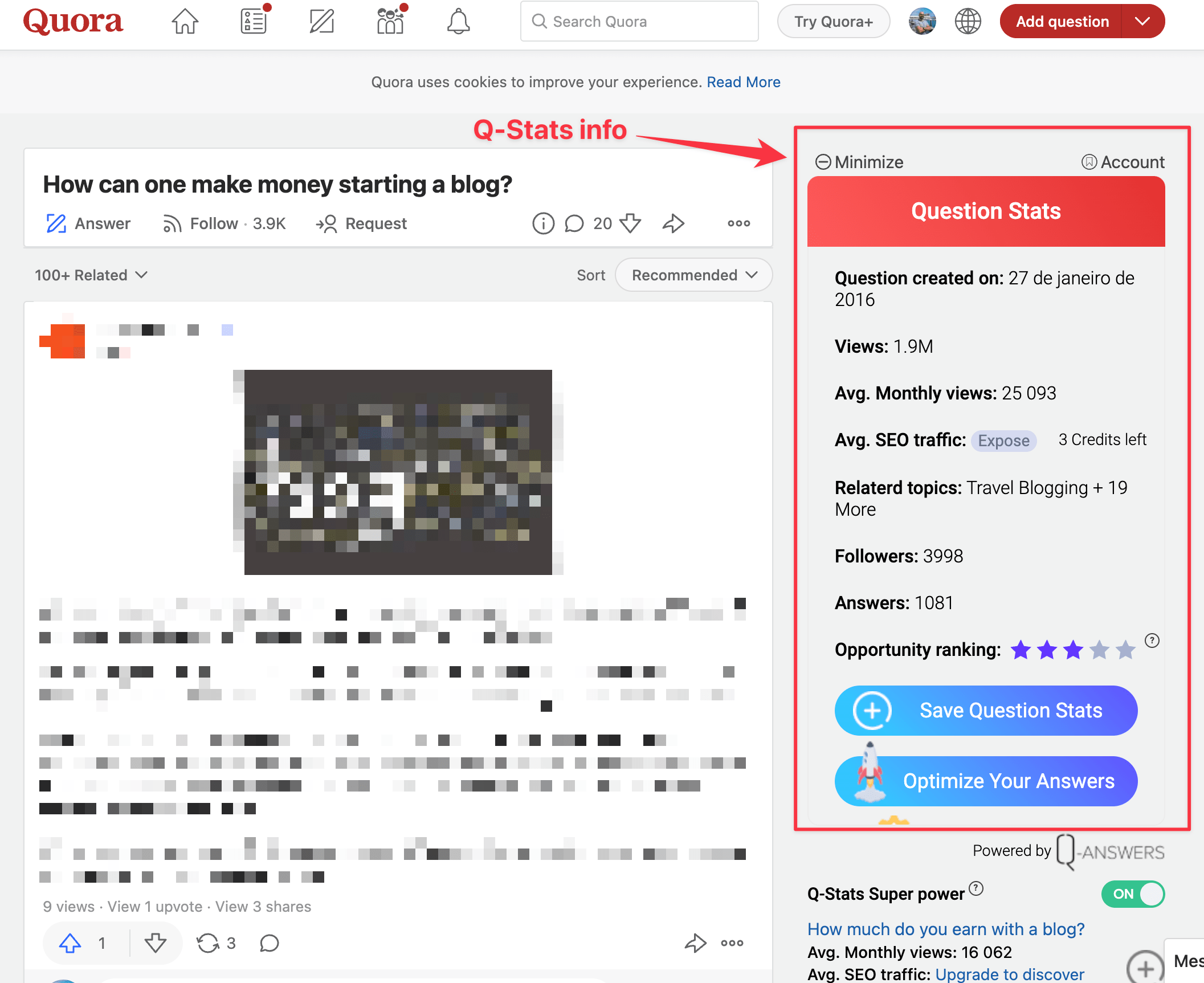
Keywords Everywhere
Keywords Everywhere is a browser extension that shows the monthly search volume, CPC, and competition for each keyword.
They get this information from Clickstream data and Google Keyword Planner (also known as Google Adwords).
Keywords Everywhere is free to use and install, but for accessing the keyword metrics you must buy credits.
Fortunately, this is a low-cost keyword research tool where 100,000 credits cost $10. To give you context, that’s more than enough for me to do research for 2 sites for 12 months.
This extension is most useful when you’re on the Google SERPs.
It will show panels with related keywords from Google autocomplete suggestions, people also search for (PASF), and long tail keywords recommendations.
They also have a “sister website” called Keyword Finder that uses the same credit system.
You can enter up to 5 seed keywords, and this tool will start searching for related and long tail variations.
This is pretty cool and faster than going to the Google search results page and copying the information from Keywords Everywhere panels.

Keyword chef
Keyword Chef is another low-cost long tail keyword research tool, and they focus on finding keywords based on user intent with the pre-defined filters:
- Questions
- Best
- Compare
- How to
- Most
- Alternatives
- Ideas
The other standout feature is the wildcard search (*). For example, if you search for “can you put * in the microwave”, Keyword Chef will loop the alphabet to find suggestions in the place of the wildcard. In this case, they might return results like:
- “can you put glass in the microwave”
- “can you put aluminum in the microwave”
- “can you put plastic plates in the microwave”
After each search, you get a report with keywords suggestions, and the last column to the right will show the SERP analysis.
This number is how many “weak” results Keyword Chef believes there are in the SERP.
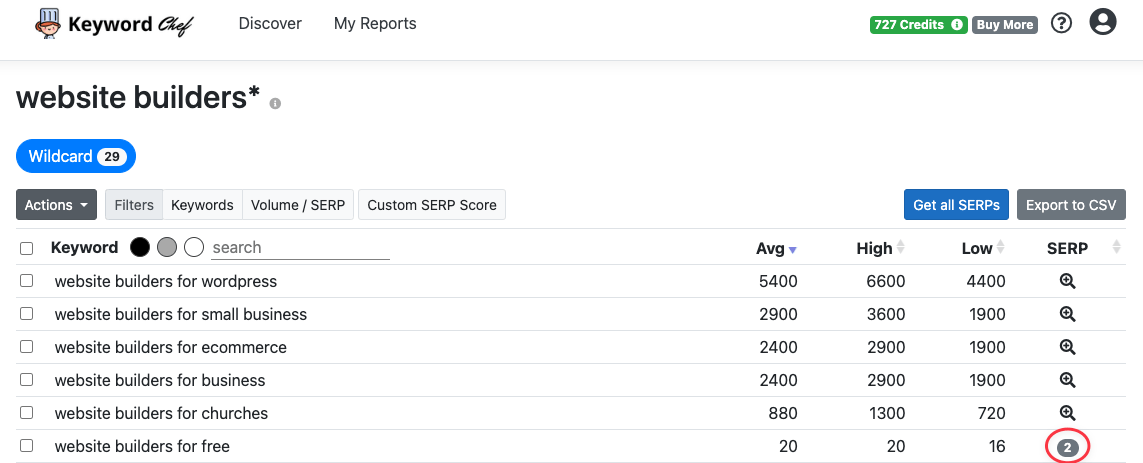
FAQs
How can long tail keywords help PPC?
From an SEO perspective, long tail keywords are less competitive and convert better as the content reflects what the buyer persona is searching for more accurately. But they can also improve your PPC and Google Ad campaigns because you can:
- Come up with a list of less competitive keywords.
- Create ads that specifically target these long tail keywords.
- Create landing pages that reflect the long tail keyword and searcher intent.
How to use long tail keywords?
You can use long tail keywords in 2 ways:
- As the main topic of a new article.
- As a heading within an existing article related to the seed keyword.
Creating a new article for the long tail keyword works better for building a cluster of pages related to the head term.
Also, consider this approach if the search intent varies for each long tail keyword. This way, you can address the user’s needs and questions better.
How to rank for long tail keywords?
To rank for long tail keywords, mention the keyword in your article, and create good quality content that explains the topic well. It’s also essential that you address the user search intent with your article if you want to rank well.
Occasionally you will rank for keywords you aren’t targeting or mentioning in your article. We call these accidental keywords. If this happens, analyze to see if it’s worth adding these keywords to your article to improve your rankings.

Summary
If you are working on a new or established site and want to get more organic traffic quickly, focus on long tail keywords.
SEOTesting makes it easy for you to find the long tail keywords your site is already ranking for. You can then create great content targeting them, and watch new clicks roll in.
Sign up to SEOTesting today with a 14-day free trial and find reports that will save you time and make your life easier.

